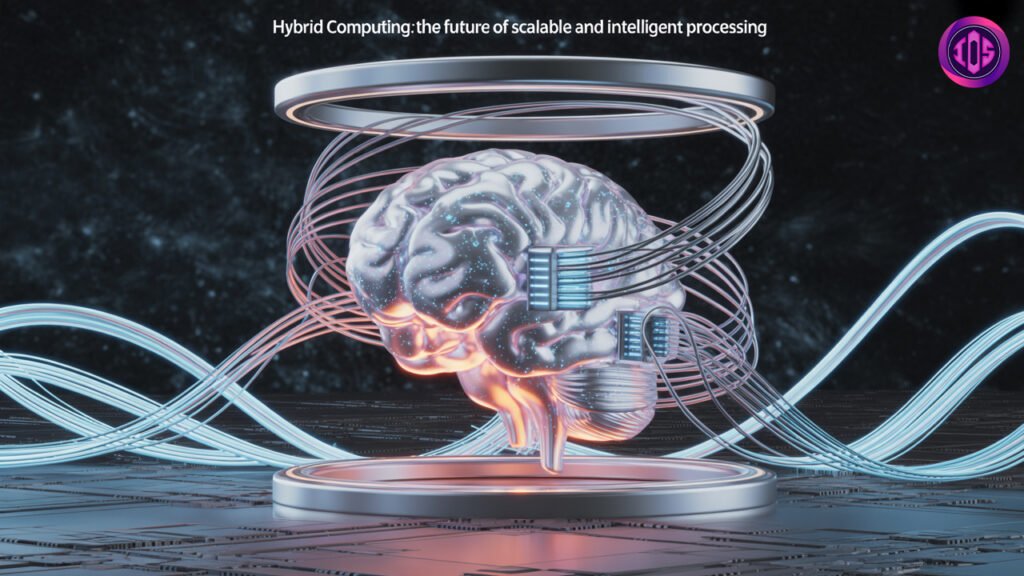Defining Hybrid Computing in the Modern Era
Hybrid computing is redefining how modern computing systems are built and scaled. It combines classical computing methods with alternative paradigms such as quantum computing, neuromorphic processors, and AI accelerators. The goal of hybrid systems is to utilize the strengths of each architecture to solve specific classes of problems more efficiently. For instance, classical CPUs excel at sequential tasks, while GPUs and TPUs are optimized for parallel processing in AI. By integrating multiple types of processors within a unified infrastructure, hybrid computing systems address the limitations of any single technology. This architecture is especially relevant in research, data analytics, and simulations where precision, speed, and scalability are essential. Hybrid computing is not just an evolution, it’s a necessity in a world demanding exponential increases in processing power.
Evolution from Classical to Hybrid Architectures
The path from classical to hybrid computing reflects the growing need for diversity in computational approaches. Traditional von Neumann architectures, though versatile, face scalability issues with increasingly complex workloads. Hybrid computing emerged as a response, allowing multiple processing units to collaborate dynamically. This evolution was driven by the limitations of Moore’s Law and the explosion of data-intensive tasks like deep learning, real-time analytics, and cryptography. Multicore systems, GPU accelerators, and programmable FPGAs formed the first stage of hybrid computing. Today, advanced systems integrate quantum processors, AI chips, and cloud-native frameworks to further enhance performance. These heterogeneous environments demand new programming models and orchestration layers to manage workloads efficiently. Hybrid computing represents not just a hardware innovation, but a foundational shift in how computation is distributed and executed.
Core Components of a Hybrid Computing System
A hybrid computing system integrates various components, each optimized for specific workloads. At its core, it consists of general-purpose CPUs for basic computation and control logic. Graphics Processing Units (GPUs) are used for parallel processing tasks such as machine learning and 3D rendering. Tensor Processing Units (TPUs) accelerate matrix-heavy AI computations. Field-Programmable Gate Arrays (FPGAs) provide flexibility in custom logic implementation. In emerging systems, quantum processing units (QPUs) are integrated to solve problems like optimization and molecular modeling. These components are connected through high-speed data buses, often coordinated by sophisticated resource managers or schedulers. A hybrid infrastructure also requires robust software layers, including compilers, middleware, and APIs, to allocate workloads dynamically based on task complexity. Together, these components deliver computing power, flexibility, and precision across diverse application domains.
Quantum-Classical Hybrid Models
Quantum-classical hybrid computing is one of the most promising advancements in high-performance computing. These systems integrate quantum processors with classical environments to execute specific algorithmic subroutines that benefit from quantum parallelism. Tasks such as optimization, cryptography, and materials simulation are especially suited for this architecture. In these models, the classical system handles preprocessing, I/O management, and error correction, while the quantum system performs the computationally intensive quantum operations. Platforms like IBM Qiskit and Microsoft Azure Quantum offer APIs that facilitate this hybrid integration. The success of quantum-classical hybrids depends heavily on low-latency communication channels and hybrid programming languages that orchestrate tasks between the two realms. As quantum technology advances, these hybrid systems will play a critical role in achieving near-term quantum advantage.
AI and Machine Learning in Hybrid Environments
Hybrid computing plays a pivotal role in enabling artificial intelligence and deep learning at scale. Training a large neural network involves billions of operations that exceed the limits of CPUs. GPUs or TPUs, designed for massive parallel processing, accelerate training tasks exponentially. A hybrid system can allocate preprocessing and orchestration tasks to CPUs, leaving heavy computation to accelerators. Real-time inference, particularly on edge devices, benefits from neuromorphic and low-power hybrid chips. These systems support mixed-precision computing, enhancing both speed and model accuracy. Popular frameworks like TensorFlow and PyTorch are now optimized for hybrid workloads. Industries including autonomous driving, healthcare diagnostics, and natural language processing rely on hybrid systems to achieve practical AI deployment. The synergy between compute architectures makes advanced AI truly deployable.
The Role of Cloud in Hybrid Computing Expansion
Cloud computing has become a primary enabler of hybrid infrastructure. Services like AWS, Azure, and Google Cloud offer hybrid compute environments that blend virtual CPUs, GPUs, and AI accelerators with cloud-native services. These platforms allow users to deploy scalable hybrid applications with minimal setup overhead. Through infrastructure-as-a-service (IaaS), organizations can build workloads that elastically scale and intelligently allocate resources. Hybrid cloud models also combine on-premise data centers with cloud services, ensuring data locality while tapping into the power of specialized processors. Kubernetes and Docker help orchestrate multi-architecture containers in such environments. As quantum computing matures, cloud providers are integrating quantum services, enabling hybrid cloud platforms with next-generation compute power. This evolution is transforming the economics and accessibility of high-performance computing.
Key Applications of Hybrid Computing
Hybrid computing supports diverse and critical applications across industries. In genomics, it accelerates sequence alignment and molecular modeling. In finance, it facilitates fraud detection and real-time trading simulations using hybrid AI and quantum optimization. Climate science uses hybrid models to run data-intensive atmospheric simulations, blending classical computation with AI forecasting. In manufacturing, digital twins operate in real-time environments with hybrid edge-cloud architecture. The automotive industry leverages hybrid systems in autonomous vehicles to perform onboard AI inference while connecting to cloud-based decision layers. Logistics platforms use hybrid computers for demand forecasting and route optimization. Even national security agencies apply hybrid computing in encryption and surveillance analysis. These real-world implementations demonstrate that hybrid computing is no longer conceptual; it is industrially indispensable.
Challenges in Hybrid Computing Deployment
Despite its advantages, hybrid computing presents a number of technical and operational challenges. Integrating diverse processing units requires specialized software environments and compatible APIs, which can complicate development and maintenance. Scheduling and workload balancing become more complex, especially when incorporating real-time constraints or quantum subroutines. Data transfer latency between heterogeneous systems, including CPU-GPU and classical-quantum layers, can become a bottleneck. Moreover, debugging and benchmarking hybrid workloads is difficult due to the asynchronous nature of multi-architecture execution. Security also becomes a concern as data flows across multiple platforms, including cloud and edge environments. Addressing these challenges requires the development of unified toolchains, hybrid-aware compilers, and open standards for interoperability. These foundational layers are essential for maximizing performance and scalability in hybrid deployments.
Future Outlook and Innovations
The future of hybrid computing is both promising and dynamic. Innovations in quantum error correction, neuromorphic chips, and photonic computing are expanding the boundaries of what hybrid systems can achieve. Emerging architectures are exploring tighter integration between classical and quantum processors on shared substrates, potentially reducing latency and improving coherence. AI-driven orchestration layers will autonomously assign tasks to the most suitable compute unit, optimizing energy efficiency and performance. Open-source projects are already developing hybrid compilers and multi-architecture frameworks that abstract the complexity of underlying hardware. As demand grows for real-time intelligence, especially in edge and IoT contexts, hybrid systems will become more decentralized, adaptive, and resilient. Long-term, hybrid computing may serve as the architectural bridge toward post-classical computing paradigms capable of solving problems previously deemed intractable.
Conclusion:
Hybrid computing marks a fundamental evolution in the design of intelligent, scalable, and high-performance computing systems. By merging diverse architectures such as CPUs, GPUs, FPGAs, and quantum processors it offers tailored solutions to increasingly complex computational demands. This architecture addresses the shortcomings of single-system processing by dynamically allocating tasks based on their nature and resource requirements. As data continues to grow in volume and complexity, hybrid systems will be essential for applications ranging from AI and scientific research to financial modeling and digital infrastructure. However, realizing its full potential requires continued innovation in software orchestration, hardware interoperability, and developer tooling. As industries and research institutions invest in hybrid frameworks, they are not merely upgrading systems, they are laying the groundwork for the next era of computing. The future is undoubtedly hybrid, and its impact will be both transformative and enduring.


